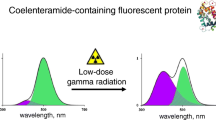Abstract
The study addresses the application of fluorescent coelenteramide-containing proteins as color bioindicators for radiotoxicity evaluation. Biological effects of chronic low-dose radiation are under investigation. Tritiated water (200 MBq/L) was used as a model source of low-intensive ionizing radiation of beta type. ‘Discharged obelin,’ product of bioluminescent reaction of marine coelenterate Obelia longissimi, was used as a representative of the coelenteramide-containing proteins. Coelenteramide, fluorophore of discharged obelin, is a photochemically active molecule; it produces fluorescence forms of different color. Contributions of ‘violet’ and ‘blue-green’ forms to the visible fluorescence serve as tested parameters. The contributions depend on the coelenteramide’s microenvironment in the protein, and, hence, evaluate distractive ability and toxicity of radiation. The protein samples were exposed to beta radiation for 18 days, and maximal dose accumulated by the samples was 0.28 Gy, being close to a tentative limit of a low-dose interval. Increase of relative contribution of ‘violet’ fluorescence under exposure to the beta irradiation was revealed. High sensitivity of the protein-based test system to low-dose ionizing radiation (to 0.03 Gy) was demonstrated. The study develops physicochemical understanding of radiotoxic effects.

Coelenteramide-containing protein (discharged obelin) changes fluorescence color under exposure to low-dose ionizing radiation of tritium





Similar content being viewed by others
Abbreviations
- CLM:
-
Coelenteramide N-[2-benzyl-6-(4-oxocyclohexa-2.5-dien-1-ylidene)-1H–pyrazin-3-yl]-2-(4-hydroxyphenyl) acetamide
- CLM-CFP:
-
Coelenteramide-containing fluorescent protein
References
Belogurova NV, Kudryasheva NS. Discharged photoprotein obelin: fluorescence peculiarities. J Photochem Photobiol B. 2010;101:103–8. doi:10.1016/j.jphotobiol.2010.07.001.
Belogurova NV, Kudryasheva NS, Alieva RR, Sizykh AG. Spectral components of bioluminescence of aequorin and obelin. J Photochem Photobiol B. 2008;92:117–22. doi:10.1016/j.jphotobiol.2008.05.006.
Alieva RR, Tomilin FN, Kuzubov AA, Ovchinnikov SG, Kudryasheva NS. Ultraviolet fluorescence of coelenteramide and coelenteramide-containing fluorescent proteins. Experimental and theoretical study. J Photochem Photobiol B. 2016;162:318–23. doi:10.1016/j.jphotobiol.2016.07.004.
Vysotskiĭ ES, Markova SV, Frank LA. Calcium-regulated photoproteins of marine coelenterates. Mol Biol (Mosk). 2006;40:404–17.
Frank LA. Ca(2+)-regulated photoproteins: effective immunoassay reporters. Sensors. 2010;10:11287–300. doi:10.3390/s101211287.
Alieva RR, Belogurova NV, Petrova AS, Kudryasheva NS. Effects of alcohols on fluorescence intensity and color of a discharged-obelin-based biomarker. Anal Bioanal Chem. 2014;406:2965–74. doi:10.1007/s00216-014-7685-z.
Petrova AS, Alieva RR, Belogurova NV, Tirranen LS, Kudryasheva NS. Variation of spectral characteristics of coelenteramide-containing fluorescent protein from Obelia longissima exposed to dimethyl sulfoxide. Russ Phys J. 2016;59:562–7. doi:10.1007/s11182-016-0806-8.
Alieva RR, Belogurova NV, Petrova AS, Kudryasheva NS. Fluorescence properties of Ca2+−independent discharged obelin and its application prospects. Anal Bioanal Chem. 2013;405:3351–8. doi:10.1007/s00216-013-6757-9.
Illarionov BA, Frank LA, Illarionova VA, Bondar VS, Vysotski ES, Blinks JR. Recombinant obelin: cloning and expression of cDNA, purification, and characterization as a calcium indicator. In: Methods Enzymol. Academic Press; 2000. p. 223–49.
Yacimirski KB, Malikova TV. Spectroscopic methods in chemistry of complex. Moscow: Khimiya; 1984.
Shimomura O, Teranishi K. Light-emitters involved in the luminescence of coelenterazine. Luminescence. 2000;15:51–8. doi:10.1002/(SICI)1522-7243(200001/02)15:1<51::AID-BIO555>3.0.CO;2-J.
Li Z-S, Zou L-Y, Min C-G, Ren A-M. The effect of micro-environment on luminescence of aequorin: the role of amino acids and explicit water molecules on spectroscopic properties of coelenteramide. J Photochem Photobiol B. 2013;127:94–9. doi:10.1016/j.jphotobiol.2013.07.022.
Min C, Li Z, Ren A, Zou L, Guo J, Goddard JD. The fluorescent properties of coelenteramide, a substrate of aequorin and obelin. J Photochem Photobiol Chem. 2013;251:182–8. doi:10.1016/j.jphotochem.2012.10.028.
Tomilin FN, Antipina LY, Vysotski ES, Ovchinnikov SG, Gitelzon II. Fluorescence of calcium-discharged obelin: the structure and molecular mechanism of emitter formation. Dokl Biochem Biophys. 2008;422:279–84. doi:10.1134/S1607672908050086.
Fedorova GF, Menshov VA, Trofimov AV, Tsaplev YB, Vasil'ev RF, Yablonskaya OI. Chemiluminescence of cigarette smoke: salient features of the phenomenon. Photochem Photobiol. 2017;93:579–89. doi:10.1111/php.12689.
Roda A, Guardigli M. Analytical chemiluminescence and bioluminescence: latest achievements and new horizons. Anal Bioanal Chem. 2012;402:69–76. doi:10.1007/s00216-011-5455-8.
Kudryasheva NS, Tarasova AS. Pollutant toxicity and detoxification by humic substances: mechanisms and quantitative assessment via luminescent biomonitoring. Environ Sci Pollut Res. 2015;22:155–67. doi:10.1007/s11356-014-3459-6.
Kudryasheva NS, Rozhko TV. Effect of low-dose ionizing radiation on luminous marine bacteria: radiation hormesis and toxicity. J Environ Radioact. 2015;142:68–77. doi:10.1016/j.jenvrad.2015.01.012.
Rozhko TV, Badun GA, Razzhivina IA, Guseynov OA, Guseynova VE, Kudryasheva NS. On the mechanism of biological activation by tritium. J Environ Radioact. 2016;157:131–5. doi:10.1016/j.jenvrad.2016.03.017.
Selivanova MA, Mogilnaya OA, Badun GA, Vydryakova GA, Kuznetsov AM, Kudryasheva NS. Effect of tritium on luminous marine bacteria and enzyme reactions. J Environ Radioact. 2013;120:19–25. doi:10.1016/j.jenvrad.2013.01.003.
Kratasyuk VA, Esimbekova EN. Applications of luminous bacteria enzymes in toxicology. Comb Chem High Throughput Screen. 2015;18:952–9. doi:10.2174/1386207318666150917100257.
Girotti S, Ferri EN, Fumo MG, Maiolini E. Monitoring of environmental pollutants by bioluminescent bacteria. Anal Chim Acta. 2008;608:2–29. doi:10.1016/j.aca.2007.12.008.
Acknowledgement
This work was supported by the state budget allocated to the fundamental research at the Russian Academy of Sciences (project 01201351504) and by the Russian Foundation for Basic Research, Grant No. 16-34-00695.
Author information
Authors and Affiliations
Corresponding author
Ethics declarations
Conflict of interest
The authors declare that they have no conflict of interest.
Rights and permissions
About this article
Cite this article
Petrova, A.S., Lukonina, A.A., Badun, G.A. et al. Fluorescent coelenteramide-containing protein as a color bioindicator for low-dose radiation effects. Anal Bioanal Chem 409, 4377–4381 (2017). https://doi.org/10.1007/s00216-017-0404-9
Received:
Revised:
Accepted:
Published:
Issue Date:
DOI: https://doi.org/10.1007/s00216-017-0404-9




